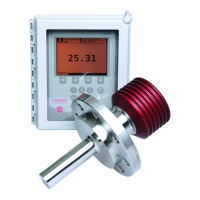40
PR-23 instrucon manual
6.1.2 Linear damping
If the process has fast step changes, linear (fast) damping gives shorter settling time.
In the linear damping (fast damping), the output is the running average of the signal
during the damping time. After a step change the signal rises linearly and reaches the
inal value after the damping time. The linear damping gives the best trade-off be-
tween random noise suppression and step change response time. Use the 4 DAMPING
TIME menu item to set the damping time. Please note that for similar noise suppres-
sion a longer damping time has to be speciied than for the exponential damping.
Figure 6.2 shows how linear damping time affects the measurement.
Figure 6.2 Linear damping
6.1.3 Slew rate limit
If the process signal has short erroneous high or low peaks, the slew rate limiting can
be used to cut their effects. The slew rate damping limits the maximum change for
the output signal in one second. It should be noted that the slew rate limit damping is
recommended for random noise suppression as it is non-linear.
The slew rate limit can be set through the menu item 5 SLEW RATE. Typical values de-
pend on the concentration unit but are typically from 0.05 % to 1 % when the concen-
tration is measured in percentages. Figure 6.3 gives an example of different slew rate
limits.
Note: Avoid overdamping, the signal should not be made insensitive.
6.2 Conguring output signal hold funconality
The instrument can be conigured to temporarily hold its measurement result in three
different cases.

